18.4: Step-by-step direct marketing process
- Page ID
- 24973
Growing a database
Running a successful direct marketing campaign requires a business to have a genuine opt-in database. This database, or, list of subscribers who have agreed to allow a company to send them emails or SMSs with marketing messages, is the most valuable asset of a direct marketing campaign.
Permission must be explicitly given by all users to whom messages are sent. Companies that abuse this can put their reputation in jeopardy, and in many countries, legal action can be taken against companies that send unsolicited bulk messages also known as spam.
It is important to track the permissions that are generated for each user. A time stamp is a key part of the data capture and opt-in process and helps to protect you against spam complaints and potential legal action.
Spam is unsolicited bulk email or SMS messages. It means that the recipient has not given permission to be sent that message. While estimates of spam differ, Statista (2016) shows that the amount of email spam has dropped from over 70% in 2014 to around 55% in 2016. SMS Promotions (2016) indicates that the amount of SMS spam differs according to region, from around 1% of total messages in North America to around 30% in Asia.
Growing this database while keeping it targeted is a key factor in any direct marketing campaign. The database need have only one entry, the prospect’s email or phone number, but the following should also be considered:
- Name, surname and title
- Date permission granted
- Source of permission
- Gender
- Country
- Date of birth
- Phone number or email (depending on which you already have)
- Frequency (how often they’d like to hear from you).
Fields such as name, surname and title should be separated in your database. You should also gather date of birth as opposed to a prospect’s age as it ensures that your database can stay up to date.
Don’t be tempted to ask for more information than required. The more information a marketer can gather, the better he or she can customise marketing messages. However, the more information a prospect is required to give, the less likely they are to sign up. Further information can be requested over time.
As always, the best long-term strategy for growing your database is to create valuable, shareable content that users want to read.
There are many ways to attract prospects to opt in to a database. An email sign up form on a company website is vital. Visitors to a website have already expressed an interest in a company by clicking through and this is an opportunity to develop that interest further. Following the same principle, any other properties where newsletter or SMS sign up can be promoted should be taken advantage of.
Consider having a sign-up form on your company blog, email signatures, Facebook page, and mobi site, or perhaps mention it during presentations you deliver. And don’t forget other offline marketing channels that you’re already using, such as flyers, posters or in-store displays. Many brands use competitions to encourage opt-ins as well. Remember, users are more likely to opt in with an email address than a mobile phone number on most channels.
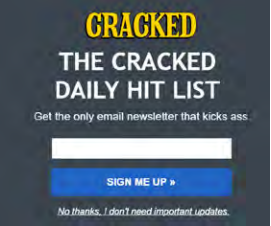
Here are some best practice tips for sign-up forms:
- Put the sign-up form where it can be seen, above the fold and on every page.
- State your anti-spam stance explicitly, and be clear that you value subscribers’ privacy.
- Clearly state what the subscriber’s information will be used for.
- Use a clear call to action.
- Include a benefit statement. Tell subscribers what they will get, and how often they will get it.
- Ensure the email address or phone number is correct by checking the syntax.
- Test to see what works best!
Every interaction can be used to ask permission to send marketing material, though some work better for email than mobile.
- Offer something valuable, and ask them to sign up to your email newsletter at the same time, for example, white paper, gift voucher, music track.
- Add a newsletter subscribe box to the checkout process of your retail site.
- Use interactions at trade shows to ask for email addresses and possibly phone numbers.
- Ask for email addresses or phone numbers in-store.
- Call out your email campaign on your social networks, and link through to your subscription form.
- Users will often submit their phone number and email address to enter a competition.
Designing an email
Emails should be created and viewed as HTML for desktop and most mobile devices. Simpler phones require basic text emails. Be sure to check your audience’s preferred devices carefully, as cheaper smartphones are becoming available, which increases their penetration into lower-income areas.
Text emails are the small, plain ones; text only, as the name suggests. If you use a Windows Operating System, and you open Notepad and type there, you will be creating a text file. As these are text only, the copy really counts here.
HTML emails are the emails with more complex design. These emails can contain images, different fonts and hyperlinks. They’re probably what you’ve had in mind throughout this chapter when we referred to email marketing.
Parts of an email
Refer to the images of the full newsletter later in this chapter to see how these elements look in context.
Sender information
This includes the ‘to’, ‘from’ and ‘reply to’ fields. These are opportunities to build a relationship through creating a perception of familiarity. In other words, the reader needs to perceive that the newsletter is somewhat unique and sent personally by the publisher. Using a personalised company email address, for example, trevor@ company.com, for the ‘reply’ field creates familiarity and builds trust with the reader provided the name is recognisable. Otherwise, using the brand name is fine. The ‘from’ address should also include the organisation’s name. A meaningless ‘from’ address that the reader cannot identify serves only to confuse the origin of the newsletter.
Subject line

The subject line may be the most important part of an email! Subject lines help the reader to identify the email and entice them to open it. The subject line is also scrutinised by spam filters, so you should avoid using unusual characters, for example, ‘#2$%&^^%###’ or ‘!!!!!’. Emojis such as smiley faces or hearts can sometimes work, you’d need to test to see what works for you.
Consistent subject lines using the name of the company and the newsletter edition can build familiarity and help readers to sort their inbox. Subject lines should also reflect the content of the email. As with everything online, testing different subject lines will lead marketers to the formula that works for them. Some brands have found that using emojis can improve open rates, while others have had no success with them, for example.
Preheader
The preheader is a line or two of text displayed above your email header. Most commonly, it’s the line of text that will redirect you to ‘View online’. Where possible, try including your call to action in the preheader. This could be difficult, given the limited space but it does ensure that every recipient, even those who don’t necessarily open the email, but who view only the preheader within the preview pane or inbox, will still be exposed to it.

Header
The header is the colourful banner or image that is included in many emails. This often contains the logo, which is important for branding, as well as a CTA or image to catch the recipient’s attention. Not every email will have a header, but these do provide added impact.

Personalised greeting
With a database that has the capability to store readers’ names, it is possible to personalise the greeting of the email. “Hi, Kim Morgan” can elicit far better responses than “Dear Valued Customer”, but it is possible to create a greeting with personality without personalising it. Occasionally, the subject line can be personalised as well to boost responses.

Body
This is where the content of the email goes. Don’t be tempted to use too many images; they can increase the size of the email, and obscure text when images do not load. Be sure that text can be read without an image being loaded. The structure must allow readers to scan and navigate the email easily. Short paragraphs, emphasis through bolding and colours, as well as sectioning information with bullets and borders all contribute to a well-structured email.
Footer
A standard footer for emails helps to build consistency, and is the customary place to keep the contact details of the company sending the email. At the very least, this should include the name, physical address and contact email of the company. It can also include the privacy policy of the sender or even extra copy to reinforce branding. One way to grow the email list is to add a ‘forward to a friend’ link in the footer or, more commonly, social media buttons. The most important part of the footer is a clear unsubscribe link.
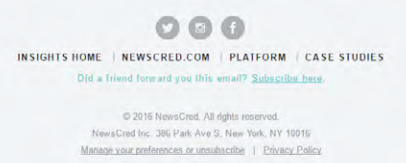
Unsubscribe link
In many countries, it is mandatory to have an unsubscribe link on all commercial emails. In best practice terms, you should also include a link for managing subscription preferences – this lets the receiver decide exactly which emails they receive from you, rather than opting them out from all of your email marketing.
Working with templates
Read more about this in the User experience design chapter.
An email template is a predesigned structure you can use for each email you send; you just need to slot content into the appropriate sections. Some email service providers offer ready-made templates for you to use. As with website templates, paid-for email templates come with some benefits and disadvantages. While they are often cheaper than commissioning a custom template, they can be inflexible and generic, meaning that they will not uniquely represent your brand. If you are choosing a template to buy, consider picking the plainest one, so that you can adapt it to your brand as needed.
Take a look here for some free email templates as a place to get started: https:// www.campaignmonitor. com/email-templates/
A custom-designed email template will allow you to plan your own content structure and ensure it displays well across many email readers and devices.
When having your template designed, it’s important to test it with a number of email readers, browsers and mobile devices so that you can ensure that it displays correctly. This can become challenging as some users still use preview panes to read their email.
Design considerations
How an email looks is integral to how well it is received by your database. Design also refers to how it is built, which can impact whether the email is delivered and how likely users are to interact with it. Some design considerations are included below. A few of these are a little more technical, so make sure that your email partner has these covered for you.
The look and feel
Studies have found that users read or scan emails following an F-shape (Nielsen, 2006). A follow-up study by the German Research Center for Artificial Intelligence looked at how users read text on smartphones, testing different layouts and paragraph lengths, and found that the F-shape still applies (Biedert, Dengel, Buscher, and Vartan, 2012). So, plan your important information to follow this flow.
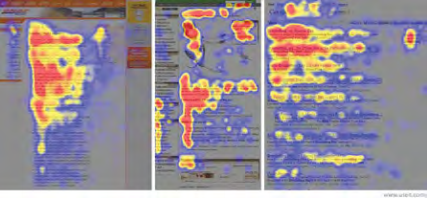
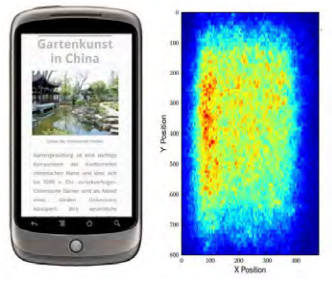
Cluttered inboxes and busy subscribers mean an email that’s lengthy and difficult to get through probably won’t be read. Help your subscribers by structuring your email content into segments, making use of borders or colour blocks to accentuate and divide content. It’s important to balance image and text in your emails. Make a point of placing images next to the relevant text.
General design guidelines
Read more about this in the Web development and design chapter.
HTML and CSS design principles differ for web and email. Here are a few things to keep in mind when designing your email:
- Don’t make use of external or embedded style sheets and avoid unnecessary embedded rows and columns.
- Make use of table nesting as far as possible, as this is generally considered to render the best results with difficult email clients. Email designers tend to make use of tables to design their email layout, using inline styles within these tables.
- Set a fixed width for your email by specifying the width and spacing of each cell rather than the entire table. When these specifics are not declared, email clients tend to render the email according to their own defaults and can break the design.
Naturally, your email design should echo your overall corporate identity and personality
- If you are using a block background colour, be sure to include a 100% width table to cover the entire email.
- Keep fonts in your email design larger than 16px. Anything below that becomes difficult to view in mobile. Also bear in mind that, while coloured text (or light-on-dark text) may look visually impressive, it can be difficult to read an entire email like this and may strain your subscribers’ eyes. Rather limit such visual tricks to smaller sections of your email, or to emails that contain less written content. • Make use of inline CSS. Some email clients strip the CSS from the head and body of the email.
- Test your emails in a variety of email clients before you send.
- Use responsive design!
Designing for the preview pane
Many email users still use desktop clients to manage their email. Given the number of emails users receive on a daily basis, many still prefer to view emails in their preview panes rather than opening them. This has added another challenge for designers who want to ensure that their emails display properly.
Images and layout should consider the preview pane and be tested for rendering. Preview panes can be vertical or horizontal.
Tips for designing for the preview pane:
- There is no set width, and we reiterate that testing is the way to go. A width of 600px works best for preview pane display (HubSpot, 2016).
- Ensure that plain, email-friendly fonts are used toward the top of your email in order to ensure that the first text encountered is properly displayed.
- Consider carefully what images you display in the top section of your email, and test displays accordingly.
- Placing your logo prominently in the top left of your email can ensure optimal brand recognition and exposure.
- Try to include your call to action in the area displayed in the preview pane. That way, even if subscribers choose not to read your email, they’ll still see your primary message.
- Some successful email templates use the area likely to be seen in the preview pane to provide a table of contents for the email. Users know what they can look forward to when opening the email.
Email and images
Avoid using images to convey important content. Make sure that there is alt text for all images used in the email. This ensures that the message of the image will still be communicated even if the image itself is not seen. Even though most email clients display images by default, some users may still not see them. Your email should make sense whether or not the user can see images.
The images you use in the email should support the overall message, rather than convey it directly. If the image doesn’t appear, the message should still be clear.
Tips for using images in email design:
- In the past, background images did not render well in emails, but this is changing. A block background colour tends to display well across most email clients. Some email clients, like Outlook, still do not display background images.
- When including images in your HTML, be sure to declare the height and width for each image to ensure consistent rendering across most email clients.
Emails that make sense without images and render correctly across all platforms are more likely to persuade a reader to open the email and click through to the website.

The call to action
Email design should support the calls to action. For your campaign to be effective, your goals and KPIs should be supported by the email layout and design. Calls to action can be hyperlinked text (also called text links), or can be images which look like buttons. Don’t forget though, that if images are blocked, your buttons will be blocked too.
Check out this article for examples of good email CTAs. www. campaignmonitor. com/blog/emailmarketing/2016/03/75- call-to-actions-to-usein-email-marketingcampaigns
Generally, both text links and CTA buttons are effective for generating clickthroughs, though some studies find that buttons perform better. While you should use buttons for links that support your CTA, for example, ‘make a booking’, ‘check availability’, your email shouldn’t be littered with them, and hyperlinks should be used for additional links. You should test them to see what kinds of CTAs perform best for you.
The copy of the CTA is exceptionally important: a well-crafted and enticingly written CTA makes a big difference to the performance of your campaign. Again, test variations to determine what drives the highest clickthrough and conversion rates on your campaigns.
Testing
The design should be tested to ensure that it renders clearly in as many clients as possible. Make sure that images line up, that copy is clear and that all the links work.
SMS best practice
Structuring an SMS involves considerably fewer considerations than writing an email. Keep in mind:
- The core concern for SMS writing is that they are limited to 160 characters, which means the hardest part of writing one is finding a way to convey your core message with very limited space.
- Part of your SMS needs to be dedicated to offering an opt-out option so that users feel in control of the communications.
- Because the mobile phone is so personal, sending relevant, targeted SMS messages is imperative. Make sure that your mobile opt-in database is very carefully segmented; 200 subscribers who actually want to hear from you are far more valuable than 2 000 who feel annoyed or harassed by your messages.
- Think about when you send your messages, are they being sent at a time that is relevant to your customer? If you are sending a sales promotion message, are you sending it at 6 a.m. in the middle of the month, or at 10 a.m. on a weekend after payday?
- Make sure that if your SMS includes a next step such as clicking through to a website, the landing page is mobile-optimised.
SMS is often best used for customer relationship management, but you can also use it to send promotions targeted to a time of day when your customers are likely to be out shopping or aimed at specific demographics or geographic areas. Just remember, as with all direct marketing, these messages need to be relevant and valuable to your customer.
Creating content
Content that is relevant and valuable to readers is vital to ensuring the success of a direct marketing campaign. Valuable content is informative and should address the problems and needs of readers. It is important to realise that the reader determines the value of the content, not the publisher. Newsletters can offer:
- Humour
- Research
- Information
- Promotions
- Exclusive content.
SMS messages can offer:
- Special offers and discounts
- Information
- Time-dependent discounts
- Celebrations
- Contests
- Trivia or voting
- Reminders.
Determining the content of your direct marketing messages is an important element of your overall brand content strategy.
Read more about this in the Content marketing strategy chapter
Any copy written for your brand should follow a predetermined brand voice guide. Consistency is important and will dictate how your customers trust and build a relationship with your brand.
The principles of writing good online copy apply. You should start with the most important information first, and make sure that your language is scannable, meaning that it makes use of the appropriate formatting, such as bolding and bulleted lists.
It may be helpful to review the Digital copywriting chapter at this stage, but there are two elements that are important to highlight now with respect to writing for direct marketing.
Read more about this in the Digital copywriting chapter.
- The first is in-message links. It’s important to consider that any links you include in your email copy will lead readers away from your email. You’ll want to keep these to a minimum, and include a link only when it is a call to action, a legal requirement or a service feature. Links in SMS messages should be shortened with a URL shortener like Bitly and should lead to a mobileoptimised page.
- The second element is, for email, the all-important subject line. Many users decide whether or not to open an email based on their first point of contact: the subject line.
For an email newsletter, it’s useful to put together a recurring content structure. The example shown here depicts a consistent content structure with repeating elements.
Note how the same elements recur for every newsletter, creating consistency and delivering on reader expectations.
If your newsletter contains a lot of content, you can use enticing snippets with a link to the full article displayed elsewhere, such as in your company blog. Sending out too much long content in your newsletter can be daunting for time-starved readers and they may not make it all the way through your newsletter.
However, if your newsletter consists of only one article, it may help to publish it in full.
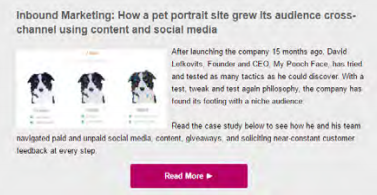
Content in an SMS obviously needs to be more concise. You should get to the point as fast as possible, which can mean including price points so that users know immediately if they are interested. Remember to include an opt-out option.

Segmenting your database
The technology of direct marketing allows for mass customisation; it is one-to-one marketing on a macro scale. Even simple personalisation can see improved results.
Customisation covers everything from using the recipient’s name, to sending the correct email version to their device, to sophisticated measurement of a recipient’s preferences and tailoring content to suit them. This is even more important for SMS marketing, where content that doesn’t interest the reader can actively damage their relationship with your brand.
Segmenting a database can allow for customisation across demographics or purchase history. For example, you may choose to divide your database according to gender or age. A political campaign may benefit from targeting slightly different messages to different demographics. A pet store may find it useful to segment their list according to the different kinds of pets their customers own. In this way, it is possible to send messages that are slightly different and tweaked to different target groups.
Other options include segmenting by location, user behaviour on site, or position in the sales funnel, for example, potential or existing customers.
Deploying
By creating valuable content, establishing the correct frequency and testing your messages for display and deliverability, an email marketer should be able to ensure an excellent delivery rate. Consistency in deploying newsletters also aids in fostering trust and fulfilling expectations.
When should you send emails? Common sense tells you not on Monday morning or Friday afternoon, but this varies by audience. Testing will guide you. Generally speaking, the best days of the week to send emails are between Tuesday and Thursday. SMS messages need to be timed even better, given that they will be delivered immediately to a device the consumer is carrying with them. Best times for delivery will vary depending on type, according to SMS Global (2016).
- General marketing messages should be sent between 10:30 and 11:30 a.m or 2:30-3:30 p.m.
- Appointment reminders should be sent 24 hours and/or directly after the appointment is made.
- Weekend sales and special events reminders should be sent on Thursdays or on the morning of the event. As always, of course, you need to test send times to check which works best for your customers.
Sender reputation
Email reputation is a score given to you depending on how well your emails are regarded by Internet Service Providers (ISPs) and your subscribers. If the sender’s score falls within the ISP’s thresholds, a sender’s messages will be delivered. If not, the sender’s emails may arrive in the bulk or spam folder, be quarantined, or be bounced back to the sender.
How it works: There are various authentication systems that can impact your reputation score. One of these is the Domain Keys Identified Mail (DKIM) and Domain Name System (DNS). DKIM associates domain names with individual email addresses, ensuring that each organisation has to take responsibility for emails sent that are associated with their domain. Basically, DKIM signs out any outbound emails.
The DKIM signature is added to the email header and includes an encrypted code. The receiving mail server will then take that DKIM signature and verify it with the DNS system to find the matching DKIM public key. Once it has this key, it can use it to unlock the encrypted code. If the code hasn’t been changed, the email hasn’t been tampered with, which means it can be authenticated and passed into the receiving mail server.
Becoming an effective email marketer requires constant list cleansing and hygiene. In fact, most lists shrink by about 22% each year as a result of subscribers changing email addresses (HubSpot, n.d.). Build a preference centre and send out an email once a year asking subscribers to update their details. Make sure you are diligent about maintaining a current opt-in list to achieve maximum deliverability via reputation.
Tips to help your reputation score:
- ISPs offer various authentication standards such as Sender ID, sender policy framework (SPF), and DomainKeys. We highly recommend the use of these standards.
- Remember that a huge but inaccurate and outdated database is far less useful to an email marketer than a tightly maintained, smaller database. Strive to boost your database, but don’t forget to clean as you go.
- Ensure that email broadcast rates are not too high.
- Respond to complaints and unsubscribe requests, if someone requests to be unsubscribed, do so. If you don’t, there’s a good chance you’ll face stiff penalties.
- Educate users about white lists.
An email’s reputation score can be checked at www.senderscore.org.
If the recipient has given permission to be sent marketing messages by email, then it is not spam. Users give permission when they tick a box that says, “Yes, please send me offers from your company by email/phone”. The email address can be provided to another company only if the user ticks a box that says, “Yes, please send me offers by email from third parties selected by you”.
The success of your direct marketing relies on users explicitly indicating that they want to hear from you. Don’t break your customer’s trust.
Permission for any kind of direct marketing must be explicitly given to the company. Trying to gain permission in a sneaky way is illegal and should never be done.
An email’s spam score can be checked at spamassassin.apache.org.
SMS credibility
Reputation via SMS is just as important; consumers are becoming increasingly suspicious of marketing messages in general, so reputation is important to convince the customer even to take your message seriously.
To make sure your SMS is credible, you’ll need to pay attention to how it’s written, the message itself, the words you use, and so on. Time of delivery is also important, as is branding the message so that your customer knows who it’s from. Remember the key: send users only what they want, when they want it, and you’ll be trusted.


